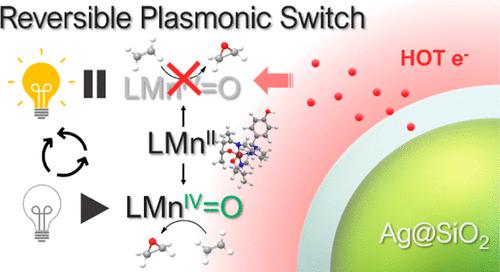当前位置:
X-MOL 学术
›
ACS Catal.
›
论文详情
Our official English website, www.x-mol.net, welcomes your
feedback! (Note: you will need to create a separate account there.)
Reversible Plasmonic Switch in a Molecular Oxidation Catalysis Process
ACS Catalysis ( IF 11.3 ) Pub Date : 2022-08-01 , DOI: 10.1021/acscatal.2c02287 Aikaterini Gemenetzi 1 , Constantinos Moularas 2 , Loukas Belles 2 , Yiannis Deligiannakis 2 , Maria Louloudi 1
ACS Catalysis ( IF 11.3 ) Pub Date : 2022-08-01 , DOI: 10.1021/acscatal.2c02287 Aikaterini Gemenetzi 1 , Constantinos Moularas 2 , Loukas Belles 2 , Yiannis Deligiannakis 2 , Maria Louloudi 1
Affiliation

|
Currently, plasmonic nanoparticles (PNPs) are considered highly efficient enhancers of catalytic processes. Herein, we report a concept where plasmonic Ag0@SiO2 nanoparticles can reversibly switch-off an oxidation catalytic process under light-excitation. The catalytic process recommences when illumination is stopped. The catalytic system under study is a well-characterized molecular LMnII catalyst that performs alkene oxidation, with H2O2 as the oxidant. Three types of plasmonic core–shell Ag0@SiO2 nanoparticles, with a SiO2 shell of varying thickness (0.1–5 nm), were utilized in this study. Using electron paramagnetic resonance spectroscopy, we have identified the reversible inhibition of the transient LMnIV═O intermediate formation, to be the key-step of the photoinduced pause of the catalytic process by the Ag0@SiO2 PNPs. Surface-enhanced Raman spectroscopy (SERS) and redox potential data show that the plasmonic Ag0@SiO2 NPs exert a moderate SERS effect on the LMnII catalyst, and a considerable lowering of the solution redox potential Eh. Our data show that near-field generation is not the sole origin of inhibition of LMnIV═O formation, while plasmonic heating was insignificant. We suggest that the generation of hot electrons by the Ag0@SiO2 PNPs is implicated, along with near-field generation, in the reversible switch-off of the catalytic process.
中文翻译:

分子氧化催化过程中的可逆等离子体开关
目前,等离子体纳米粒子(PNP)被认为是催化过程的高效增强剂。在这里,我们报告了一个概念,其中等离子 Ag 0 @SiO 2纳米粒子可以在光激发下可逆地关闭氧化催化过程。当照明停止时,催化过程重新开始。所研究的催化系统是一种性能良好的分子LMn II催化剂,它以H 2 O 2作为氧化剂进行烯烃氧化。三种类型的等离子体核-壳 Ag 0 @SiO 2纳米粒子,具有 SiO 2本研究使用了不同厚度(0.1-5 nm)的外壳。使用电子顺磁共振光谱,我们已经确定了对瞬态 LMn IV = O 中间体形成的可逆抑制,这是 Ag 0 @SiO 2 PNPs 光诱导催化过程暂停的关键步骤。表面增强拉曼光谱 (SERS) 和氧化还原电位数据表明,等离子体 Ag 0 @SiO 2 NPs 对 LMn II催化剂具有中等的 SERS 效应,并显着降低了溶液氧化还原电位E h。我们的数据表明,近场产生并不是 LMn IV抑制的唯一来源═O 形成,而等离子体加热是微不足道的。我们建议 Ag 0 @SiO 2 PNPs 产生的热电子以及近场产生与催化过程的可逆关闭有关。
更新日期:2022-08-01
中文翻译:

分子氧化催化过程中的可逆等离子体开关
目前,等离子体纳米粒子(PNP)被认为是催化过程的高效增强剂。在这里,我们报告了一个概念,其中等离子 Ag 0 @SiO 2纳米粒子可以在光激发下可逆地关闭氧化催化过程。当照明停止时,催化过程重新开始。所研究的催化系统是一种性能良好的分子LMn II催化剂,它以H 2 O 2作为氧化剂进行烯烃氧化。三种类型的等离子体核-壳 Ag 0 @SiO 2纳米粒子,具有 SiO 2本研究使用了不同厚度(0.1-5 nm)的外壳。使用电子顺磁共振光谱,我们已经确定了对瞬态 LMn IV = O 中间体形成的可逆抑制,这是 Ag 0 @SiO 2 PNPs 光诱导催化过程暂停的关键步骤。表面增强拉曼光谱 (SERS) 和氧化还原电位数据表明,等离子体 Ag 0 @SiO 2 NPs 对 LMn II催化剂具有中等的 SERS 效应,并显着降低了溶液氧化还原电位E h。我们的数据表明,近场产生并不是 LMn IV抑制的唯一来源═O 形成,而等离子体加热是微不足道的。我们建议 Ag 0 @SiO 2 PNPs 产生的热电子以及近场产生与催化过程的可逆关闭有关。











































 京公网安备 11010802027423号
京公网安备 11010802027423号